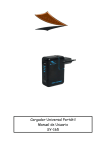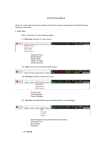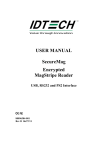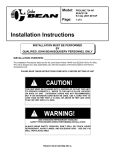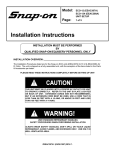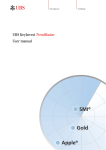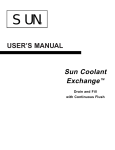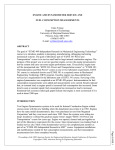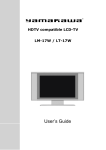Download here - Snap-on Equipment
Transcript
Special Instructions When viewing this service manual, you will see references to the “Pro-Cut” part numbers. In order to correctly identify these parts in the “EquiServ” parts system the part numbers will require minor changes i.e. The part number will be preceded by a “PC” identifier and all dashes are removed. Example Pro-Cut = 50-085 EquiServ = PC50085 JBC 520 Principles of operation The JBC 520 aligns the axis of the lathe to the hub’s axis. Instead of using a pair of runout screws to eliminate compensate for runout, it uses one screw. By precisely positioning that screw by spinning the ring, you can adjust for runout by only applying correction exactly where it is needed. This eliminates trying to get two screws in combination to eliminate the runout. Background on Lateral Runout Low Point -0.015 360 345 330 315 300 285 270 255 240 225 210 195 180 165 150 135 120 90 105 75 60 45 30 0 15 Lateral Position Lateral run-out is caused by an angular misalignment between the vehicle hub and the lathe spindle. The motion this misalignment causes happens once per revolution of the lathe. This is the steady end to 0.015 end sweep you see on a dial Source High Point indicator. As the lathe and hub 0.01 Lateral position of turn, the lateral runout starts at the lathe (inches) zero, goes up to its high point, 0.005 Source back through zero, through its 0 low point and back up to zero. This happens each time the -0.005 spindle completes one revolution (360 degrees). This -0.01 is shown in Figure 1. ©1998 Pro-Cut International LLC INTERNAL DISTRIBUTION ONLY Page 1 of 8 360 345 330 315 300 285 270 255 240 225 210 195 180 165 150 135 120 105 90 75 60 45 30 0 15 Lateral Position In order to eliminate lateral Degrees Rotation runout, we need to introduce a second source of lateral Figure 1: Lathe runout over 1 revolution runout. We need to introduce lateral runout exactly equal to and opposite of the lateral runout that is present in the original hookup. With the 0.015 standard runout screws we Original Runout adjust two screws in 0.01 combination until they exactly 0.005 equal and opposite of the Equal Zero original lateral runout. A Source 0 Device perfectly adjusted system Adj. LRO would look like Figure 2. With -0.005 the ring device, we place the -0.01 single screw so that it is Adjustment Runout exactly opposite the high point -0.015 of the original runout then turn Degrees Rotation the screw until the added runout exactly equals the Figure 2: Corrected Lateral Runout original runout. This makes the total motion zero. Ring Device The ring device is composed of three main sections. The base section (50-664) is bolted to the lathe. The ring portion (50-662) rides over the base and under the top plate (50-665). The whole device is held together 36-114 (2) with bolts (35-232) which pass through the device, through springs (50-055) and into nylon lock nuts (36114). The springs let the top plate move when the 50-664 (2) ring screw (35-234) is engaged. The whole device is bolted to the lathe spindle with four socket cap screws (35-233). The bottom of the adjustment ring has a machined ridge opposite the set-screw. When the setscrew is tightened the ring 50-055 (2) acts like a tripod with one adjustable leg. If the set50-664 screw is set exactly 50-662 35-232 (2) at the JBC 520 Adjustment Device 35-234 50-665 high point of the initial runout, the initial runout and the adjustment will cancel each other exactly. If the adjustment screw is not exactly at the high point of the runout the runout will be reduced, but will never be eliminated. Therefore, accurate positioning of the ring device is necessary to compensate for runout. 35-233 (4) The ring device itself is purely mechanical. It can function with or without the electronics system. All that is required of the ring is that the high point is located accurately. Ridge So what happens when the ring is not located accurately? The following illustrations show what happens to the total runout when the ring is incorrectly placed. Screw Figure 3 Bottom of Adjustment Ring ©1998 Pro-Cut International LLC INTERNAL DISTRIBUTION ONLY Page 2 of 8 0.015 0.015 1 2 Initial LRO 0.01 Initial LRO 0.01 0.005 0.005 Source Source -0.005 -0.01 -0.01 -0.015 -0.015 Total LRO: 0.024” Total Peak Phase: 90° 360 345 330 315 300 285 270 255 240 225 210 195 Device Adj. LRO Compensation Initial LRO: 0.024” Compensation: 0.010” 0.015 180 165 150 135 120 90 105 75 60 45 30 0 360 345 Adj. LRO -0.005 Initial LRO: 0.024” Compensation: 0.000” 15 0 Device 330 315 300 285 270 255 240 225 210 195 180 165 150 135 120 90 105 75 60 45 30 0 15 0 Total LRO: 0.014” Total Peak Phase: 94° 0.015 4 0.01 0.01 0.005 0.005 -0.005 -0.01 -0.01 -0.015 -0.015 Total LRO: 0.005” Total Peak Phase: 110° Initial LRO: 0.024” Compensation: 0.022” 0.015 330 315 300 285 270 255 240 225 210 195 180 165 150 135 120 105 90 75 60 45 30 0 Adj. LRO -0.005 Initial LRO: 0.024” Compensation: 0.020” 15 360 345 330 315 300 285 270 255 240 225 210 195 180 165 150 135 120 105 90 75 60 45 30 0 15 Source 0 Device Device 360 Source 0 345 3 Adj. LRO Total LRO: 0.004” Total Peak Phase: 135° 0.015 5 6 0.01 0.01 0.005 Source -0.005 -0.01 -0.01 -0.015 -0.015 Total LRO: 0.003” Total Peak Phase: 180° Initial LRO: 0.024” Compensation: 0.026” 330 315 Device Adj. LRO Total LRO: 0.004” Total Peak Phase: 225° As you can see the total runout is minimized at 0.003” in step 5, but not entirely eliminated. Note the position (phase) of the high point when it is at its minimum. The high point is exactly between the initial LRO and the compensation (180°). If you keep tightening the screw, the phase shoots past 180° very quickly. The phase of the total LRO is how the computer determines whether the sign displayed to the technician is + or −. Note that the amount of total runout changes very little. This is why a technician can move the screw a small amount and have the sign on the electronics change from minus to plus (or vice versa) while the total number displayed changes very little. If you see this occurring, you know that you are at the minimum total runout that you can achieve with the ring at its current position. ©1998 Pro-Cut International LLC INTERNAL DISTRIBUTION ONLY Page 3 of 8 300 285 270 255 240 225 210 195 180 165 150 135 120 105 90 75 60 45 30 0 Adj. LRO -0.005 Initial LRO: 0.024” Compensation: 0.024” 15 0 360 Device 345 330 315 300 285 270 255 240 225 210 195 180 165 150 135 120 105 90 75 60 45 30 0 15 0 360 Source 345 0.005 Any error that leads to the computer calculating an ring position that is incorrect will lead to this ‘hunting’ back and forth around a particular value that keeps switching from + to −. This can be due to: ♦ ♦ A problem with the string sensor-sticky or rough action of the string or the string is not wrapped around the nylon pulley. The string is not straight. This leads the sensor to interpret RADIAL runout to be LATERAL runout. It cannot distinguish between the two. It only measures how far the string moves in and out. The string can be angled if the trolley handle is not tight and the lathe rotates when you start the motor. A good workaround to unresolved ‘hunting’ is to remove the lathe from the adapter, spin the adapter 180° and hook back up. Check that the string is straight, hit the reset button and start again. Electronics & Electromechanical Systems The electronics & electromechanical systems are designed to assist the technician in determining where to place the ring and how much to turn the screw. All runout values it displays are calculated for a nominal 10” diameter rotor. There are four major components in the electronics & electromechanical systems. They are: the electronics box, the string reel sensor unit, the tachometer and the wiring harness. All four systems need to work, or else the electronics will malfunction. Electronics Sub Systems The Tachometer: Located directly under the ring device is a small black sensor. It registers a pulse once each rotation. A slot cut into the base portion of the ring device creates this pulse. This is very similar to a gear tooth counter used in many automotive systems. This sensor is responsible for letting the control unit know that the lathe is running, and that it is running consistently and at the right speed. Common problems with this part include: ♦ ♦ Loose or damaged connection at the junction to the main wire harness. The tach sensor is too far from the ring device. Proper distance is 1/8” or less. The String Reel Unit: This unit is mounted on the bottom of the bevel gear box (50-012). It consists of a retractile cable unit, the shaft encoder, nylon pulley and housing. There is also a short spur wire that runs between the outside of the housing and the encoder. This unit senses rotation of the encoder shaft and sends the data back to the controller. The cable needs to wrap smoothly around the pulley one time. There can be no binding, catching or stiction. It must be wrapped as shown: under, around, under and out. When in use, the sensor cable needs to come straight out of the cover. Sensor Cable Nylon Pulley 1 2 Shaft Encoder Spur wire Retractile Cable Unit Reel Unit Cover ©1998 Pro-Cut International LLC INTERNAL DISTRIBUTION ONLY Page 4 of 8 Common problems include: ♦ ♦ ♦ ♦ ♦ Sensor cable frayed or broken Sensor cable no longer wrapped around the nylon pulley Sensor cable wrapped around the nylon pulley backwards Spur wire is disconnected from the shaft encoder or is connected backwards Sensor cable not connected to the vehicle or not straight ♦ Sensor cable not feeding in and out smoothly Complaints that they technician cannot get past a yellow light most often point to a problem with the reel sensor unit. If the motion of the encoder shaft lags behind the actual motion of the machine the electronics will not report the correct ring position to the operator. If the ring is incorrectly positioned the LRO will get down to the lowest it can go, and then the electronics will just change the sign of the LRO, but not the amount. Complaints that the live mode counts up instead of down are because the sensor cable is wrapped around the pulley backwards. The two ends of the sensor cable as they come off the nylon pulley should be parallel. The cable starts below the nylon pulley, is wrapped up and around the pulley one time, and then goes out the keyhole. If the cable is wrapped the around the pulley in the wrong direction, the cable will come out of the small rectangular part of the keyhole slot. If the cable is wrapped the around the pulley in the right direction, the cable will come out circular part of the keyhole. Use needle-nose pliers to wrap and unwrap the cable around the nylon pulley. Be careful not to kink the sensor cable. The Controller: Mounted on the lathe trolley, the controller (computer) is responsible for gathering and interpreting the data from the tachometer and string reel unit. It then displays the high point phase (ring position) and lateral runout to the technician. There are two buttons on the controller. The one on the left is the reset button. This erases any information in the controller and starts the program at the beginning. It can be pressed at any time to reset the unit. However, during normal operation, there should be no need to press this button. The right hand button switches the unit from the measuring mode to the live adjustment mode and makes the display act like a dial indicator. The other features on the controller are the text display and the cable junctions. It is not possible to mis-wire the controller to the harness to the control unit. Common problems include: ♦ ♦ ♦ ♦ Cable damage from tension on the wire harness. This is most often caused when flipping the lathe. Four black squares, and four blank spaces on the display. A jammed button most often causes this. Open the electronics box and be sure that the reset and live adjustment buttons are free to move up and down. Also be sure that either the sensor is not pressing the button on the backside of the circuit board or power wires. Works properly on one side but doesn’t on a successive cut. The controller has a 5minute time-out. It will reset itself after 5 minutes of not receiving a tachometer pulse. If you begin to do a second brake job less than 5 minutes after finishing the first, you will need to press RESET before you begin. Whenever you begin a brake job the controller should flash between READY and RELEASE SCREW. No power at the electronics box/no lights come on. Check AC connections and power at the wall outlet, inside the motor junction box and at the back of the electronics box. ©1998 Pro-Cut International LLC INTERNAL DISTRIBUTION ONLY Page 5 of 8 ♦ Electronics show 0.000” runout when there is obvious motion in the machine. This happens when one of the two channels from the shaft encoder is interrupted. Check the sensor connection at the back of the electronics box for damage or low pins, and the connections at the reel unit. The Wiring Harness: There are three main branches to the wiring harness and three small spurs. The first brings AC power from the motor junction box to the control unit. This is a 120 (220V if used in Europe) AC line, so take normal precautions when servicing it. The wires in it are black (hot), white (neutral) and green (ground). It ends in a female 4-prong connector that is attached to the back of the control unit. Note that only three of the four connections are used. If this wire is damaged or disconnected you will get no lights whatsoever in the control unit. The second and third branches of the wiring harness actually begin together at the eightpin connector at the back of the controller. Three of these wires go to the tachometer (DC +, DC -, and ground). Four of these wires go to the string reel unit [1 DC (+), 2 DC () (channels A&B), 1 ground]. The eighth terminal is used to connect the cable shielding to ground. This protects against false electrical signals from strong fields, like those created by arc welders (or lathe motors starting up). There are also three small spur wires that connect to the main harness. The first of these was mentioned when I described the string reel unit. It goes from the outside of the reel unit to the shaft encoder. Please note that the connection to between the shaft encoder and the spur wire is the only connection that is possible to wire backwards. The purple wire should be attached at the top of the shaft encoder. The unused socket on the connector belongs at the ‘Index’ position. The back of the encoder has printing on it if you have any question as to which is the ‘Index’ position. The other two spurs are inside the controller and go from the connectors on the back of the unit to the circuit board. One is for AC power and goes to a white three or five prong connector on the circuit board, and the other goes to a brown connector for the sensor data. The wiring harness is the part most susceptible to damage by the operator. When servicing a machine look for loose or damaged wires, especially at the back of the control box and where the wires terminate at the sensors. The Program: Understanding the controller’s program can go a long way in helping you diagnose problems with the JBC 520. How far you get in the program can tell you if one or the other of the sensors is or is not working, and can hint at which area to inspect. The flow chart on the following page shows the steps that the program cycles through. The rectangles indicate displays and the diamonds actions, such as sensor inputs. The circles represent possible outcomes. ©1998 Pro-Cut International LLC INTERNAL DISTRIBUTION ONLY Page 6 of 8 A note about the ‘Live Mode’. When the live mode is pressed, the computer takes the last calculated LRO measurement out of memory and begins to add or subtract counts from the encoder to it. It has no idea what the position of the ring device actually is. If the ring device is 90° from the line between the string and the lathe spindle, you can tighten the screw forever with virtually no change in the sensor reading. ©1998 Pro-Cut International LLC INTERNAL DISTRIBUTION ONLY Page 7 of 8 Trouble Shooting JBC 520 won’t give a green light Wire sensor not straight Straighten wire and begin again. If there is a lot of radial runout, try extending more string. Gooseneck not tight Tighten gooseneck and begin again. Adapter not properly centered. Check that all nuts sit squarely in their countersinks or that all guide plates are lined up evenly. Begin again. Ring Device needs cleaning Remove ring device from lathe, disassemble and clean. See appendix for diagram. Any wobbling between plates will cause problems when removing runout. Nylon Pulley has come off sensor Remove reel units cover and put the shaft nylon pulley back on. If it fits loosely, score the brass sensor shaft until the fit is snug. Sensor Cable no longer goes Remove reel units cover and check the around pulley. that the Sensor Cable goes around the pulley. It can come off if the technician ‘snaps’ the cable back into the unit. Use needlenose pliers to wrap the cable around the pulley one time. The two ends should be parallel when you’re done. Sensor Pulley loose on the shaft. Slide pulley over and score the brass shaft so that there is a tighter fit between the nylon pulley and the shaft. Open electronics box and check that Black boxes take up half One of the buttons is jammed in the down position. buttons are not cocked or jammed and the display, other halfalso that the power or data wires are not blank. pressing on the button on the backside of the circuit board. JBC 520 display is blank Power connector is disconnected Re-connect power cable to the back of and lathe is plugged in. the electronics unit, or check connections in the motor junction box. JBC 520 will not enter live Circuit board has come loose from Open box and tighten/replace the mode the box. standoff screws that hold the circuit board to the front of the electronics box. JBC 520 does not begin Sensor cable not attached to the Re-connect the sensor cable to the back measuring electronics unit of the electronics unit JBC 520 says, “Take a Wire sensor not attached to Attach sensor wire and begin again. cut” but there is still gooseneck obvious motion. One of the two channels from the Check all pins and connections between reel unit sensor is disconnected the sensor inside the reel unit and the electronics box. JBC 520 adjustment Unit not reset between cuts. Unit resets automatically after 5 minutes. works on one side, but If less than 5 minutes have elapsed since fails to eliminate runout on the last cut, the RESET button needs to the subsequent cut be pressed before beginning the next brake disc. ©1998 Pro-Cut International LLC INTERNAL DISTRIBUTION ONLY Page 8 of 8 Special Instructions When viewing this parts manual, you will see references to the “Pro-Cut” part numbers. In order to correctly identify these parts in the “EquiServ” parts system the part numbers will require minor changes i.e. The part number will be preceded by a “PC” identifier and all dashes are removed. Example Pro-Cut = 50-085 EquiServ = PC50085 37-182 37-003 50-251 50-364 (2) 50-701(2) 36-002 (2) 37-077 (4) 50-252 50-053 50-362 37-082 (2) 37-003 (2) 50-253 50-361 50-291 50-254 50-085 (2) 50-238 CUTTING HEAD ©1998 Pro-Cut International LLC INTERNAL DISTRIBUTION ONLY Page 1 of 6 37-057 37-056 50-024 50-526 50-012 50-464 50-021 37-056 37-057 50-023 50-499 35-922 (2) 35-926 Reel Unit Assembly 50-642 37-507 50-072 35-932 (4) 35-927 (4) 50-025 37-084 36-019 (4) JBC 520 BEVEL GEAR ©1998 Pro-Cut International LLC INTERNAL DISTRIBUTION ONLY Page 2 of 6 50-163 37-516 50-468 50-634 (110V) 50-632 (220V) 50-558 On/Off Switch 110V 50-658 50-637 35-931 35-160 50-663 50-560 36-019 50-022 37-445 Not shown: Motor mount screws 35-718 (4) Tach Sensor 37-903, Tach Sensor Mount 50466, Tach Sensor Screw 35-238, and CROS Wiring Harness 50-561. 37-004 36-113 37-725 50-564 50-465 37-054 50-659 37-433 37-010 50-567 37-493 37-494 35-230 (4) 37-492 50-646 50-638 50-566 50-568 50-565 50-651 50-570 35-926 50-679 35-925 (2) ©1998 Pro-Cut International LLC INTERNAL DISTRIBUTION ONLY Page 3 of 6 LATHE BODY JBC 520 37-251 37-620 37-619 37-517 37-456 37-108 37-519 50-537 50-511* 50-510* 50-533 37-519 36-020 37-003 37-515* *50-509 assembly 37-454 37-455 37-003 35-649 50-525 [2] 50-503 35-240 37-518 36-001A 37-108 50-507 50-504 37-108[4] 37-108 36-001B [4] 35-650 36-001A 37-454 36-001A 37-108 50-503 37-030 37-108 [4] 36-020 37-454 35-190 [4] 50-514 37-030A LATHE TROLLEY ©1998 Pro-Cut International LLC INTERNAL DISTRIBUTION ONLY Page 4 of 6 50-052 37-902 Comes w/nut & washer 36-114 37-904 37-901 50-674 35-235 REEL UNIT ASSEMBLY JBC 520 ©1998 Pro-Cut International LLC INTERNAL DISTRIBUTION ONLY Page 5 of 6 37-005 (2) 50-055 (2) 50-664 50-662 50-665 36-114 (2) 35-234 35-232 (2) 35-233 (4) ©1998 Pro-Cut International LLC INTERNAL DISTRIBUTION ONLY Page 6 of 6 JBC 520 ADJUSTMENT DEVICE
















